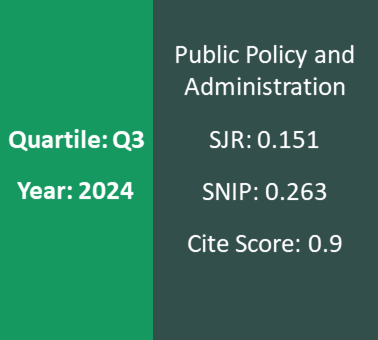Regulation, Remainder Risk, and Public Investment Fund: A Theoretical Analysis
DOI:
https://doi.org/10.5755/j01.ppaa.23.3.35624Keywords:
democracy, investments, bonds, public capital, risk management, simple majority votingAbstract
In the EU member countries that obey the rule of law principle, the legislative work of the parliament supports the market economy by producing public capital. In many cases, legislation is connected to public investment projects, and sometimes also to socially important private projects. Both include public benefits and costs, but also public risks. Moreover, as the public commitment to major private undertakings may preclude both immaterial and material contributions, there is a noteworthy threat that an accidental actualization of the remainder risk caused by some unforeseen incident would fall heavily on the taxpayers. This paper constructs a club theoretic model for the analysis of representative democracy. In the model, the public commitment to a private project is decided by the simple majority voting rule in the parliament. The analysis shows that strict assessment of the remainder risk may halt the whole undertaking implying that the promised social benefits are also lost. As a solution, we propose a constitutional Investment Fund, which would launch short-maturity public bonds to citizens and pension funds, earmarked to the material part of the public commitment to private projects. The system could partly privatize the public remainder risk so that only the immaterial part remains to common taxpayers thus increasing the probability of a majority vote for the project. At the same time, the government would get equity finance for its investments, and the citizens and pension funds would hold securities with tangible net asset value. The system should increase precision in public debt and risk management and bring democracy, public governance, and the market economy closer to each other.
References
References
Alanen, Aku and Pelkonen, Lea (2000) Can regional economic growth be explained by social capital? In Jouko Kajanoja and Jussi Simpura (eds.). Social capital: global and local perspectives. VATT-Publications 29. Helsinki, VATT Institute for Economic Research, pp. 51-70.
Blythh. Mark (2013) Austerity: The History of a Dangerous Idea. Oxford University Press.
Buchanan, James (1975) The Limits of Liberty: Between Anarchy and Leviathan. University of Chicago Press.
Buchanan, James and Brennan, Geoffrey (1985) The Reason of Rules: Constitutional Political Economy. Cambridge University Press.
de Viti de Marco, Antonio (1936) First Principles of Public Finance. London: Jonathan Cape.
Cullis, John and Jones, Philip (2009) Public Finance & Public Choice. New York: Oxford University Press.
Dietz, Graham (2011) Going back to the source - why do people trust each other? Journal of Trust Research, 1(2), 215-222. https://doi.org/10.1080/21515581.2011.603514
Emerson, Jed (1998) The Nature of Returns: The Social Capital Markets Inquiry into Elements of Investment and the Blended Value Proposition. Social Enterprise Series, 17. https://www.fi-compass.eu › files › publications
Emerson, Peter (2020) Majority Voting as a Catalyst of Populism: Preferential Decision-making for an Inclusive Democracy. Cham: Springer Nature Switzerland.https://doi.org/10.10o7/978-3-030-20219-4
Follesdal, Andreas and Hix, Simon (2006) Why There is a Democratic Deficit in the EU: A Response to Majone and Moravcsik. Journal of Common Market Studies, 44(3), 533–62. https://onlinelibrary.wiley.com › doi
Giddens, Anthony (1990) The Consequences of Modernity. Stanford University Press.
Hall, Robert and Jones, Charles (1999) Why do some countries produce so much more output per workers than others? Quarterly Journal of Economics, 114, 83-116.
Hartmann, Sönke, Pedoth, Lydia, Dalla Torrre, Cristina and Schneiderbauer, Stefan (2021) Beyond the Expected – Residual Risks and Cases of Overload in the Context of Managing Alpine Natural Hazards. International Journal of Disaster Risk Science,12, 205-219. https://doi.org/10.1007/s13753-020-00325-3
Jalava, Janne (2006) Trust as a Decision - The Problems and Functions of Trust in Lachmannian Systems Theory. University of Helsinki. http://hdl.handle.net/10138/11205
Luhmann, Niklas (1988) Trust: Making and Breaking Cooperative Relations. In: Diego Gambetta (ed.) Familiarity, Confidence, Trust: Problems and Alternatives. New York: Basil Blackwell. https://www.nuffield.ox.ac.uk/users/gambetta/Trust_making
Olson, Mancur (1971) The Logic of Collective Action. Public Goods and the Theory of Groups. Cambridge, MA: Harvard University Press.
Scharpf, Fritz (1999) Governing in Europe; Effective and Democratic? Oxford University Press.
Taleb, Nassim (2010) The Black Swan: The Impact of the Highly Improbable. Random House.
Wicksell, Knut (1896) Finanztheoretische Untersuchungen. Jena: Gustav Fischer Verlag.
Yescombe, E.R. and Farquharson, Edward (2018) Public-Private Partnerships for Infrastructure - Principles of Policy and Finance.Elsevier Ltd. https://doi.org/10.1016/C2011-0-04354-5
Zaheer, Akbar, McEvily, Bill and Perrone, Vincenzo (1998) Does trust matter? Exploring the effects of interorganizational and interpersonal trust on performance. Organization Science, 9(2), 141–159. https://doi.org/10.1287/orsc.9.2.141





